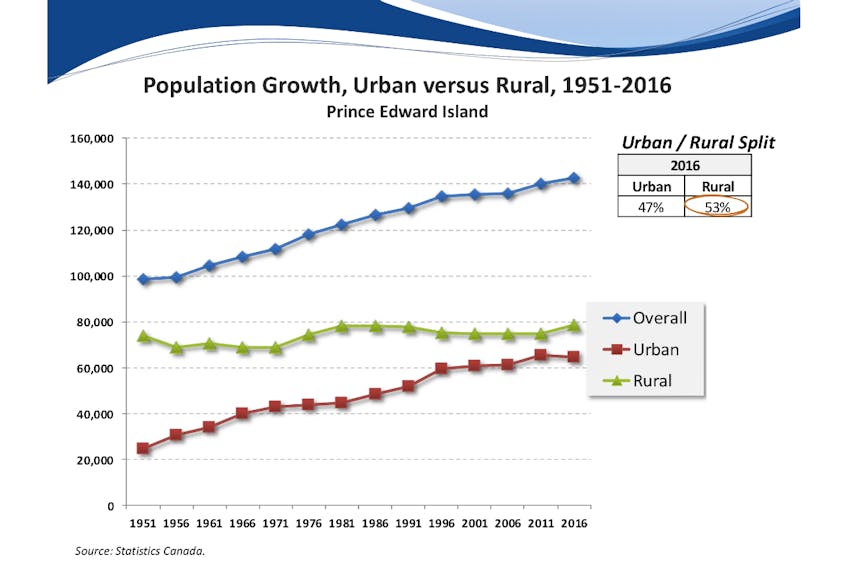In Canada, the population has grown, on average, about per cent each year for the last 65 years. Seventy percent of population growth in Canada is now attributed to immigration. In Canada, the population has grown, on average about 1% per year for the last sixty-five years. Seventy percent of population growth in Canada is now attributed to immigration.

This growth rate has served the country well by providing an ever- growing workforce to allow our economy to expand over time. I’ am not sure who first figured out that population growth was good for the economy, but growth at about 1% one per cent has been clearly at the appropriate level to be absorbed without serious disruption to the economy. As the following chart demonstratesHowever, the population growth has been virtually entirely restricted to urban communities (defined as– or, communities with at least 5,000 or more residents).
Based on the most recent census, only about 19 per cent of Canadians now live in rural communities, although the rural population remains about the same as it was in the 1950s. The distribution of the population in Atlantic Canada is dramatically different than for the rest of the country. In this region, more than twice as many Atlantic Canadians live in rural communities as the Canadian average – including 53 per cent of Islanders, the highest in the country but slowly declining. Given the small geography on the Island, the more rural nature of the population is much less a problem than in other bigger provinces.
The negative economic impacts of this higher proportion rural residents are two-fold. It limits economic opportunities available to those living in rural communities in the region and, as a consequence, makes rural Islanders The negative economic impacts associated with this higher proportion of the population living in rural communities are two-fold. The first is related to the more limited economic opportunities available to those living in rural communities in the region and their greater dependence on seasonal work as a consequence. more likely to be dependent on seasonal work. Chronic under-employment and unemployment is a drag on the region’s economy and increases the resources needed to support those living in rural communities.
Secondly, the cost of public service delivery is generally higher for provinces with higher rural populations. Think about the challenges associated with providing high-speed internet to rural communities as an example.
The lack of population growth in Atlantic Canada generally traces back to the 1990s, when the baby boom generation stopped having children. Up to that point in timeuntil then, this region had largely relied on natural birth rates to increase population. Indeed, fFor far too long, Atlantic Canada has not had its share of immigration to help grow our the population. Interestingly, PEI has bucked the overall trend across Atlantic Canada by consistently growing its population over the years, mostly through immigration.
“There is no question: Atlantic Canadians must become more open to newcomers from other countries and become more welcoming in order to ensure retention of these new citizens.” – Don Mills
According to the most recent census, the population in this region is significantly less diverse than elsewhere in Canada. This creates a challenge: Atlantic Canada remains the least diversified population in Canada due to low levels of immigration to the region over decades. In fact, while 22 per cent of the Canadian population today were born in another country, only 6.4 per cent of Islanders were born elsewhere Perhaps surprisingly, PEI has the highest percentage of immigrants in its population in Atlantic Canada, slightly ahead of Nova Scotia.
The low incidence of population diversity in the province - particularly outside Charlottetown - is a key barrier to the acceptance of those from other countries with different languages and other cultures. This is largely because the region has little experience living with diversity. This is reflected in data collected by Corporate Research Associates Inc. that indicates the majority of Atlantic Canadians believe that the region would be better off by having fewer or the same small number of immigrants that are currently being attracted to the region.

The importance and benefit of a growing population is best illustrated by the experience here on Prince Edward Island. The Island has out-performed the rest of the region over the last 10 years economically, growing its economy at nearly the Canadian average for real GDP growth and out-performing the rest of the region by more than one per cent each year in economic growth. It has created more full-time jobs than the rest of the region combined over this period. The PEI unemployment rate has dropped to its lowest level in decades. The difference in economic performance is directly tied to a consistently growing population driven largely by immigration. PEI is the model for the benefits associated with both population growth and immigration.
There’s no question: Atlantic Canadians must become more open to newcomers from other countries and more welcoming in order to ensure retention of these new citizens.
One of the challenges related to growing the population is related to the retention of immigrants and attracting immigrants to communities outside the major urban centres in the region. Nearly all the population growth in Canada has been limited to the major cities in Canada. Each urban community in the region must develop their its own population growth strategy focused on immigrant attraction and retention. Special efforts are required to inform ensure citizens are informed about the benefits of population growth and immigration as a key strategy to grow the economy, as well as the importance of being more welcoming and accepting of diversity.
In my opinion, Atlantic Canada must strive to grow its population by 1%one per cent each year to reap the economic benefits the rest of the country has enjoyed for decades.
Don Mills is the former owner of Corporate Research Associates and a recognized expert in data trends in Atlantic Canada. After selling his business recently, he remains passionate about data - and learning the guitar. He can be contacted at [email protected] or on Twitter at @donmillshfx.
RELATED









